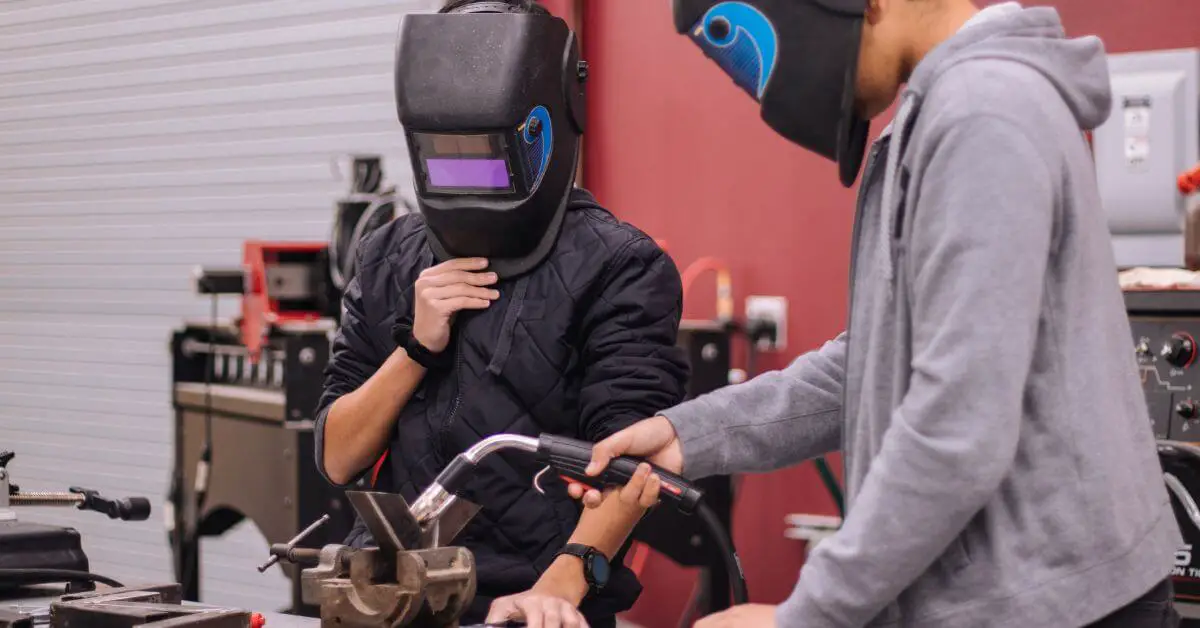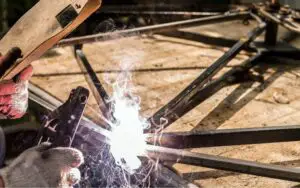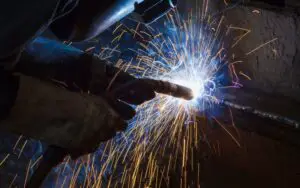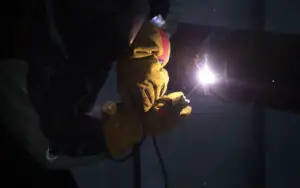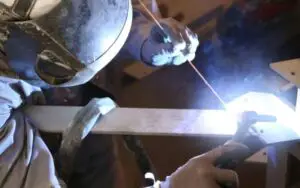Did you know welding has existed for thousands of years, dating back to the Bronze Age? Today, it remains a vital skill in various industries, from automotive to aerospace. There are different types of welding processes, and each process has its advantages and disadvantages. So, what is the best type of welding process for a beginner and aspiring welding professional?
In this article, we will dive into the world of welding, examining the various techniques, their advantages, and disadvantages, and ultimately, determine the best process for your needs. So, strap on your safety goggles, and let’s get started!
Brief about Common Types of Welding
Stick welding, flux core arc welding, TIG, and MIG welding are the commonly used welding types in the engineering industry. Each process has advantages, cons, and applications. Let us understand these different processes briefly before going further.
Shielded Metal Arc Welding (SMAW) or Stick Welding
Shielded Metal Arc Welding (SMAW) is also known as stick welding. Stick welding uses a metal filler rod, or welding electrode, coated with flux. Stick welding is an arc welding process in which the electric current flows through the gap between the flux-coated consumable electrode and the base metal, forming a welding arc.
The heat created by the arc is used to melt the base metals in the welding line and the electrode to form the molten weld pool. The molten weld pool fuses the two base metals to join them with a weld bead.
The flux coating on the electrode melts along with the electrode and forms gasses to shield the molten weld pool from oxygen, hydrogen, and nitrogen contained in the atmospheric air. The molten flux solidifies into a slag over the weld bead to protect it from contaminants and control the cooling rate.
Stick welding is one of the most inexpensive types of welding, so it’s useful for anyone trying to stay on a tight budget.
GMAW (Gas Metal Arc Welding) or MIG (Metal Inert Gas) Welding
MIG welding is an arc welding process used to weld pieces of metal together. In this welding technique, the arc is struck between an automatically fed bare metal filler wire and the base metal.
The heat generated by the welding arc continuously melts the wire electrode in the welding gun, allowing it to join to the workpiece with enough strength and visual appeal. And a shielding gas protects the arc and the weld pool from the atmospheric air.
The MIG welding torch has a nozzle, and when you press its switch to start the arc, the welding MIG wire and the shielding gas come out of the nozzle at a preselected wire travel speed and gas flow rate.
MIG welding is one of the easier types of welding for beginners to learn.
Flux-Cored Arc Welding (FCAW)
FCAW is an arc welding process, and here the arc is struck between the continuously fed flux-cored wire and the base metal, and the heat created by the arc is used for melting the flux-cored wire and the weld surface of the base metals to create the molten weld pool.
The flux-cored wire has a flux filled in the core of the wire, and this melts along with the metal wire to form a shielding gas to protect the welding arc and the molten weld metal pool (similar to stick welding). The molten flux forms a protective slag over the weld bead. You can operate FCAW with or without shielding gas.
TIG (Tungsten Inert Gas) Welding or GTAW (Gas Tungsten Arc Welding)
TIG Welding is an arc welding method where the arc is struck between a non-consumable tungsten electrode and the base metal, and a filler rod is used to add metal to the molten weld pool. It is a precise form of welding, offering the welder control to adapt the amperage and gas flow.
An inert gas (normally argon or helium, or a mix of argon and helium) is used as the shielding gas to protect the arc and the molten weld pool from the atmospheric air.
In TIG welding, the welder has the TIG torch in one hand and the filler wire in the other. And moves the TIG torch and rod along the weld line to create the molten weld pool. In most TIG welding machines, the welder requires a foot pedal switch to control the current.
A TIG welder needs perfect coordination of eyes, hands, and feet to do a good welding job. Due to this, TIG welding is considered a difficult technique to learn, and it requires more practice to master it.
Best Types of Welding for Beginners
We have briefly discussed the commonly used welding processes in the engineering industry. Which are the best types of welding for beginners to learn?
Let us review the advantages and cons of each welding method from a beginner’s point of view.
Which Welding Process is Easiest to Learn in Short Time?
| MIG welding | Stick welding |
Pros
Cons
|
Pros
Cons
|
| Flux-cored arc welding | TIG/GTAW welding |
Pros
Cons
|
Pros
Cons
|
Considering the discussion above, it is easy to conclude that MIG welding is the best welding process for beginners. You can also learn FCAW along with MIG welding. However, it would be best if you remembered that:
1. MIG welding is easy, but it cannot be learned in a day.
2. It is important to learn MIG welding (or any welding for that matter) from a professional welder with welding experience.
3. Patience is important for a welder during learning as well as when you do welding.
Once you have learned MIG welding and decided to begin your welding practice, you can buy your first welder. Think of the following before you make your decision.
Factors to Consider When Buying Your MIG Welding Machine
Do you have an old car or motorcycle that you want to restore? Do you want to undertake structural welding, automobile body welding, automobile trailers, fencing work, construction of boats, pipelines, and similar jobs? Most of these jobs can be done using a MIG/FCAW welder.
Types of Metal
MIG welding is good for welding steel, stainless steel, and aluminum. You need a spool gun for aluminum welding. Please ensure the MIG welder (you propose to buy) can weld the steel, stainless steel, and aluminum and the minimum and maximum metal thickness. Ensure it can do FCAW, also.
Power Input Required
Ensure that the MIG welder can be plugged into the power source available to you.
Budget
Consider your budget when making the decision. Remember to reserve part of your budget for safety gear (leather apron, quality welding helmet, eyeglasses, boots, hand gloves, ear muffs, etc.), shielding gas cylinders, filler wire/flux-cored wire, gas regulator, etc.
However, the advantage of MIG welding for beginners is you can start using it as a flux-cored arc welder and plan the shielding gas a little later.
Remember that the best welder for you isn’t necessarily the most expensive one. Go for an entry-level MIG welder within your budget and use it for two years. Keep saving for a better welding machine after two years and increase your business.
Frequently Asked Questions
What is the role of current in welding, and what is its relation to the thickness of base metals?
In arc welding, the current flows between the electrode or filler wire and the base metal, and an arc is formed in the small gap between them. The heat produced by the arc is used for melting the base metal and the electrode/filler wire. The amount of heat generated will increase with the increase in amperes.
Thinner base metals need smaller diameter electrodes/filler wire, and thicker metal needs bigger diameter electrodes/filler wire for welding. Also, smaller-diameter electrodes need less current (heat) to melt, and bigger-diameter electrodes need more current (heat).
Expert welders advise that the diameter of the electrode should always be ≤ the thickness of the base metal.
What is the meaning of the duty cycle in welding?
The welding power source gets heated and needs to be cooled intermittently, which is done by following the duty cycle. The duty cycle indicates the maximum period you can weld continuously in 10 minutes.
Let us take an example of a welding power source with a 50% duty cycle. You have to consider 10 minutes of working, and for this 50% duty cycle, after every five minutes of welding, the power source must be rested/cooled for 5 minutes. This cycle is repeated continuously.
I want to learn to weld. Which is the easiest welding process for a beginner?
MIG is usually the welding process experienced welders recommend for beginners. MIG welding is considered the easiest type of welding to learn since it uses a continuously fed wire welding electrode, and the arc length is maintained.
Conclusion
Welding is a good profession, and a skilled welder can command respect and money. Hopefully, this guide to welding for beginners has given sufficient information for you to make a correct decision.
References:

